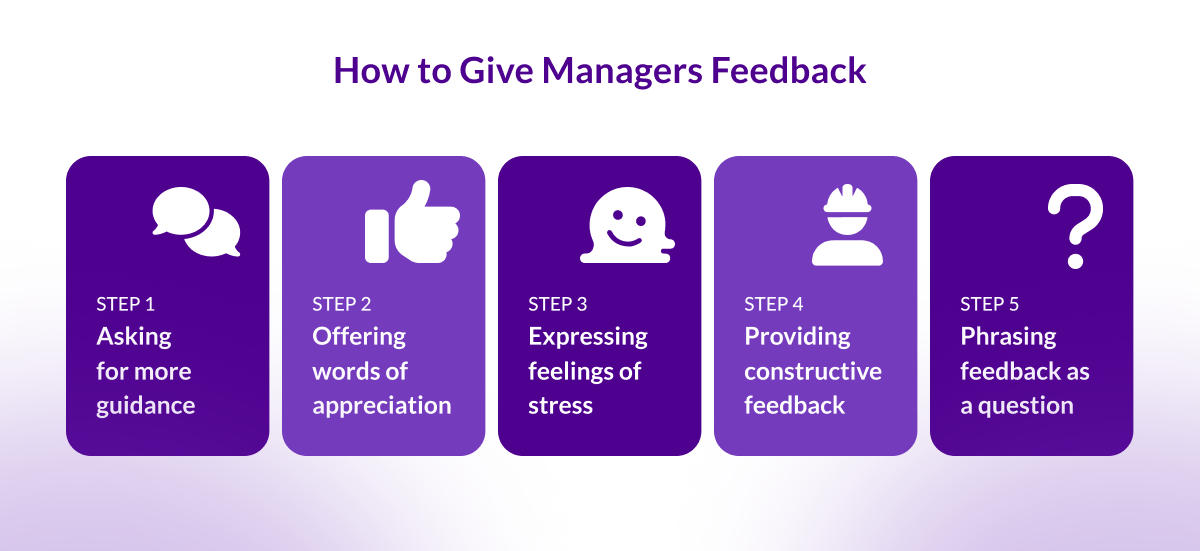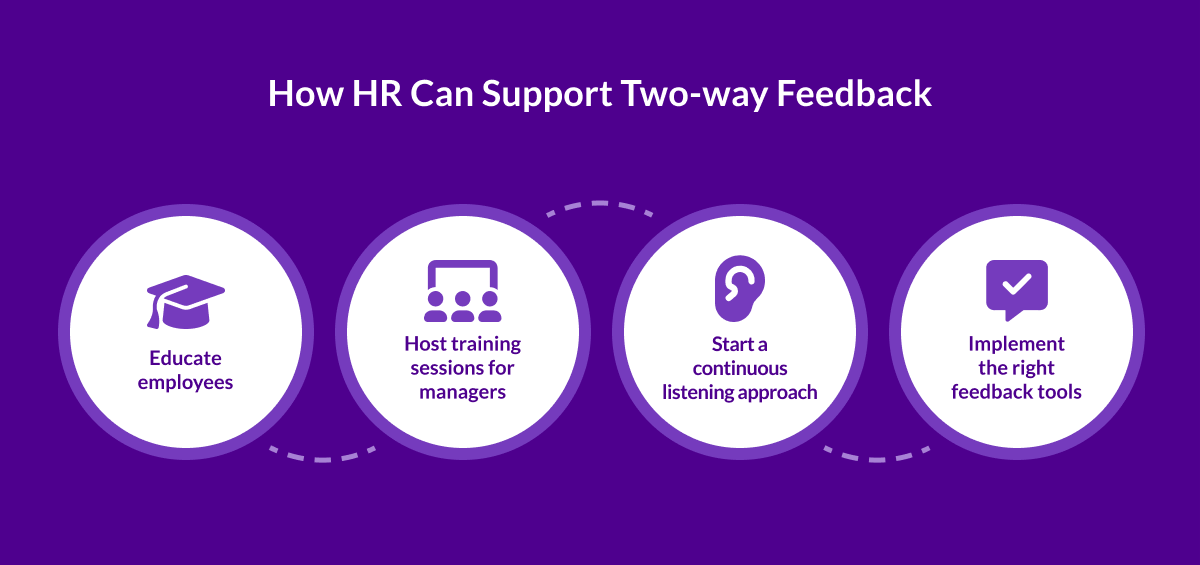Table of contents
Employee feedback is a valuable part of building a healthy organizational culture, but it’s equally important to create a space for employees to offer feedback for managers. While managers often provide feedback to their teams, receiving constructive feedback themselves is just as important. In fact, when employees feel empowered to share their thoughts, it encourages transparency, trust, and collaboration across your organization. Offering feedback for managers helps them refine their leadership skills, address blind spots, and ensure their goals are closely aligned with their team’s.
This is especially important given 70% of workers consider alignment to be the biggest obstacle when it comes to achieving company goals. These stats can be unsettling for HR professionals.
So, what can you do? Start by promoting consistent communication. But that responsibility doesn’t fall solely on your manager’s shoulders. It’s important for you as the employee to speak up about your experience and expectations, so that you can feel empowered to do your best work.
Not sure where to begin? Let Achievers help you navigate the process of providing feedback — from understanding why upward feedback matters to offering examples of effective feedback for managers, and ways your HR leaders can offer support.
Why upward feedback is important
Managers play an essential role in the employee experience. In fact, research from Achievers Workforce Institute (AWI) shows that employees recognized monthly by their managers are twice as likely as those recognized quarterly to say they are very productive and are 28% more likely to say they are usually productive at work.
Feeling engaged and motivated at work starts with leadership. Managers should encourage their direct reports to provide upward feedback regularly and hold follow-up meetings to build collaborative action plans together. Otherwise, they’ll likely experience greater employee disengagement and even worse, high turnover. In fact, the latest research from LinkedIn’s Workforce Confidence shows 69% of workers would leave their job if they had a bad manager.
That’s where upward feedback becomes invaluable. A key benefit of upward feedback is that it helps shed light on “in-the-trench” issues that managers may otherwise be unaware of. If managers know from their direct reports that employees are feeling burnout and morale is down, they can take real-time action before it’s too late. In fact, acting on feedback increases trust in company leaders by 75% more than just gathering feedback.
It’s important that employees have a safe space to be open and honest with their manager about their work challenges, whether it’s through one-on-one meetings or anonymous engagement surveys. It’s time for managers to embrace upward feedback as an opportunity to grow as a leader and engage their team. After all, 71% of employees find critical feedback helpful and motivating.
What kind of feedback should you give to a manager?
Like everyone else, managers want to hear positive feedback on their performance — but that doesn’t mean that employees can’t share constructive criticism. Employees should be encouraged to share their comments directly with their manager and should have tools and processes in place to do so effectively.
Feedback from employees to their managers can be informal or formal in nature and don’t need to be mutually exclusive:
- Informal feedback: Occurs spontaneously, in the moment or during an interaction
- Formal feedback: Planned and regularly scheduled into workflows
In general, there are four types of constructive feedback:
- Negative feedback: Critical or constructive comments about previous behavior
- Positive feedback: Affirming comments about previous behavior
- Negative feed-forward: Critical or constructive comments surrounding future performance
- Positive feed-forward: Affirming comments surrounding future behavior
While employees can provide feedback at any time, the best time to engage is often when neither individual (the employee nor the manager) are stressed or frustrated. During 1:1s, quarterly reviews, or during scheduled meeting times are good opportunities to provide manager feedback.
Feedback should be:
- Clear: Well thought-out and communicated directly with the manager
- Succinct: Concise and pointed comments based in fact
- Specific: Be prepared to provide examples and suggestions for improvement

7 examples of how to provide employee feedback for managers
In theory, giving feedback is easy, but it’s much harder to put into practice. Although it can be difficult to provide upward feedback in the moment, it’s important not to wait too long. Otherwise, the issue is likely to continue if your manager doesn’t realize there is one, and it will mean less to them after it’s finally given. It could even cause a negative reaction that nothing was said sooner.
To help make the process easier for employees, we’re sharing several best practices for giving feedback to managers, including a few real-world examples.
1. Ask for more guidance
Employees should feel empowered to tell their managers when they need more direction. For example, if you need more guidance on a project, but you know that your manager (and you) hates handholding.
Example of feedback:
“I know you’re busy, but it would help me to have more regular check-ins with you. That way, I can guarantee that I’m on the right track. I’ll better understand what you look for in final projects, get over the learning curve, and then be able to run on my own.”
This tells managers that they need to give more guidance to their employees and that there might be a communication gap. This type of upward feedback will help employees gain managerial support and direction while improving the way they communicate with their managers moving forward.
2. Offer words of appreciation
Does your manager recognize you frequently? If so, consider returning the favor. Managers want to be recognized just as much as employees. Up to 53% of senior leaders (such as VPs and directors) and 42% of senior managers want more recognition in the workplace. It’s important for employees to give managers positive feedback and offer words of appreciation.
Example of feedback:
“Thank you for making it a priority to highlight my work. I spent a great deal of time preparing that report, and it meant so much to me that you recognized my efforts in front of everyone during your presentation.”
This also lets the manager know that the employee is inspired by praise and recognition. The manager can then continue to acknowledge the good work that the employee is doing, and maybe even bring them into more meetings with senior leadership.
3. Express feelings of stress
Another situation where employees should give their managers feedback is when they’re feeling overworked or overwhelmed.
Example of feedback:
“After some thought, I believe that taking on this extra project would hinder my overall performance. I’m already dedicating 20 hours per week to my client work and another 15 hours to sales enablement, which leaves little time to help on partnerships. My concern is that I wouldn’t have enough time to fully dedicate to this new area. Can we talk about how to adjust my workload?”
Managers who receive this feedback might not realize how much their employee has taken on. There are likely ways for the manager to modify expectations or switch projects around to ensure that the employee can perform at their best.
4. Provide constructive feedback
If you’re going to say something constructive to your boss, ask whether you can provide feedback first. This is a common courtesy and prepares your manager for the potential of negative feedback. Once they agree to receive feedback, preface a difficult comment by two recognitions. Presenting words of appreciation first helps managers feel like you’re recognizing their efforts, too.
Then, dive into the issue at hand. Don’t describe what you’d do if you were the boss, or presume you know everything about the situation — this can cause manager defensiveness. Instead, try to frame your feedback in a way that highlights how you perceive a certain situation.
Example of feedback:
“You had really good insights and did a great job explaining such a large analysis. But I noticed that some people in the sales meeting looked disengaged right away. From my perspective, I’m wondering if it might help to start your presentation offering context behind why you’re holding these meetings and acknowledging the team’s recent accomplishments first, before diving into the critiques. This type of approach might resonate better with the team and remind them that you’re there to be a source of help.”
Phrasing feedback this way helps to focus on the fact that you’re working together as a team with a growth mindset approach. Remember that managers want praise for hard work as much as employees do. Think about your own experiences. It feels less criticizing to receive critiques that are balanced with praises. The same goes for your manager.
5. Phrase feedback as a question
If you’re looking for a different approach than the recognition-first method, try phrasing the feedback as a question. Put yourself in your manager’s shoes and show empathy. Make your feedback about specific actions, rather than personality. Managers should be able to address the feedback you’re giving.
It might also help to offer potential solutions. This way, you can come in with ideas and appear more proactive.
Example of feedback:
“I know it’s hard to be objective when you’re in the weeds. Would it be helpful for me to track and share my outsider observations of client receptiveness throughout the project? I could take notes that we can review each week and brainstorm on how to keep refining the project, so it gets better and better.”
Sometimes you can directly phrase your feedback as a question to simply open the conversation and put the ball in your manager’s court. For example, if you want to have a candid conversation about needing more support, you can simply ask if they think there are enough resources in place to help you meet your goals. Your manager can provide his/her thoughts and you both can continue an organic conversation.
6. Highlight areas for improvement
Giving feedback on ways your manager could improve can feel intimidating, but when it’s done thoughtfully, it can make a significant difference in the way they communicate and how effective they are as a leader. The key is to approach the conversation with a growth mindset. Rather than pointing out what’s not working, highlight opportunities for improvement and suggest ways to address them.
Example of feedback:
“I really admire how much you’re able to handle, and I know you’re juggling a lot. That said, I’ve noticed that some tasks get assigned with very tight timelines, which can make it hard for the team to meet deadlines. Do you think we could set up a process for an earlier delegation? Maybe I can help by tracking upcoming deadlines or flagging priorities in advance.”
This feedback not only communicates a concern but also offers a solution. It shows you’re on the same team, working towards shared goals. By focusing on how both of you can improve processes together, you’re making it easier for your manager to act on the feedback.
7. Share feedback about priorities
Sometimes it’s clear that a manager’s focus needs adjustment, whether it’s chasing new initiatives at the expense of day-to-day goals or spreading the team too thin. Giving feedback on priorities can feel tricky, but it’s important to share your perspective — your insights might help your manager see blind spots they didn’t realize were there.
Example of feedback:
“I appreciate how excited you are about exploring new opportunities — it keeps our work interesting! But I’ve noticed it’s pulling our attention away from some of our key deliverables. Do you think we could take a step back and review our priorities together? I’d love to share my thoughts on what I think could have the biggest impact right now, and I’m open to hearing your perspective too.”
This approach reinforces your respect for their leadership while advocating for balance. It invites collaboration, helping your manager reflect on priorities without feeling attacked. Sharing feedback like this can lead to better alignment and more meaningful progress for your team.
Feedback for managers: Questions to consider
Getting honest, constructive feedback is important for improving manager performance. The quality of the questions you ask employees about their managers matters. To get a complete picture, and to help find areas for improvement, here are five things to keep in mind when thinking about offering feedback for your manager:
1. Communication skills
Clear communication is the foundation of any successful manager-employee relationship. Providing feedback on your manager’s communication style can help them understand how their messages are received and find ways to improve. Ask yourself:
- Are you comfortable communicating with your manager?
- How often do you receive recognition from your manager?
- Does your manager clearly communicate their performance expectations?
2. Leadership skills
Providing feedback on your manager’s leadership abilities helps them understand their impact and identify areas for growth. These questions can guide how you provide your input. Focus on their capabilities, their effectiveness in managing the team, and if they’re able to lead by example. Ask yourself:
- How confident are you in your manager’s leadership capabilities?
- Is your manager equipped with the skill set to effectively manage your team?
- Is your manager a good role model for you and your team?
3. Mentorship
Mentorship is an essential part of helping employees grow professionally and feel supported in their career development. Offering feedback on this area can highlight whether your manager is creating opportunities for learning and advancement. Ask yourself:
- Would you consider your manager a mentor?
- Do you see career advancement opportunities for you within this company?
- Has your manager provided you with mentorship opportunities?
4. Support
When employees don’t feel supported at work, they’re far less likely to be engaged and excited about the work they’re doing. It’s important to ask yourself if there is an adequate level of support from the top-down, or if there are clear areas of opportunity. Ask yourself:
- Do you feel that expectations of you at work are reasonable?
- When you request support, does your manager act promptly?
- Does your manager express interest in your well-being outside of work?
5. Work-life balance
Feeling fulfilled outside of work is just as important as how you feel professionally. It’s important for leadership to show genuine interest in their employees’ well-being and mental health. Ensuring there is a balance between work and personal interests or passions can be an overlooked part of the employee experience, so it’s important that you address it early on. Ask yourself:
- Do you feel that your manager cares about your mental health and well-being?
- Do they recognize the importance of personal time?
- Does your manager encourage you to have downtime and to use vacation?

How HR can support two-way feedback
Providing feedback can feel challenging, whether it’s for your manager or your peers. But you don’t have to navigate this alone. HR plays a key role in creating a culture that focuses on open communication. By creating tools, resources, and training programs, HR ensures that feedback is a collaborative and productive process. Plus, they can train leaders to view employee feedback as an opportunity to improve their team performance and guide them on how to act on feedback quickly and in ways that align with company values.
Here are a few ways HR can support two-way feedback between employees and managers:
Educate employees
HR departments need to be the biggest advocate of two-way feedback. They should set the tone and expectations by educating managers and employees on the value that feedback offers. You should feel confident about how to use available feedback tools and resources. HR can also help ensure you feel included in your company’s culture and that your voice is valued and respected. This makes it easier to share your thoughts with your manager in a trusting environment.
Host training sessions for managers
HR plays a key role in helping managers get comfortable with always-on feedback. One of the best ways to do this is by training them to ask for feedback during regular check-ins and to be thoughtful about how they respond. HR can guide managers to pause, reflect on any missing details, and truly acknowledge how employees feel. When managers show they value feedback, employees are more likely to feel their input is meaningful and appreciated.
HR can also encourage managers to lead one-on-one and team feedback sessions, where they work together with employees to create action plans, not dictate them. Providing managers with the right tools to navigate tough conversations is crucial. After all, trivializing an employee’s thoughts or not giving straight answers can be damaging to psychological safety in the workplace.
With the right training, HR can help managers foster a safe, open environment where feedback flows both ways.
Start a continuous listening approach
Annual surveys aren’t enough on their own. To encourage regular upward feedback, HR needs to start a continuous listening approach through always-on feedback channels and frequent surveying. In fact, there is a direct connection between how often employees are surveyed and their levels of employee engagement. Our insights from our Belonging Blueprint Report found that employees who receive pulse surveys four or more times a year are 39% more likely to feel known and 75% more likely to say they feel welcomed and respected compared to those surveyed just once a year.
And with many companies still playing catch-up, it can be a competitive advantage to start a continuous listening approach across your organization.
Implement the right feedback tools
When it comes to building an engaged workplace, the right feedback tools can make all the difference. As many as 77% of employees are more likely to provide honest feedback in a survey rather than to their manager. HR leaders should offer survey tools that make it easy for employees and managers to send and receive feedback and help employees feel more comfortable providing their honest thoughts and feelings.
Start with an employee voice solution, which can help prompt meaningful, two-way conversations between both employees and their leaders. Employee voice solutions enable organizations to share feedback at any time and from anywhere through always-on feedback channels, check-ins, and surveys.
Pulse surveys are a great way to gather more regular feedback. By checking in with employees more often, managers can measure how their engagement levels change over time. Making surveys easily accessible encourages participation, produces more reliable results, and helps managers respond to feedback quickly.
Companies benefiting from employee feedback tools
Bayhealth, Delaware’s largest non-profit healthcare system, adopted an employee voice solution to level-up their employee listening capabilities beyond their annual engagement survey. Bayhealth added weekly check-ins (automated, confidential chatbot conversations where employees can share how they feel about work and their individual employee experience) and quarterly pulse surveys.
The regular check-ins have enabled front-line leaders to receive timely feedback about day-to-day issues that require immediate attention, which is a critical concern in the healthcare industry. The organization has been able to identify not only how employees feel about their work, but also why they feel that way.
The right employee voice tools should be able to provide growth ideas for manager feedback into actionable insights in real-time so they can quickly course correct any problem areas with their team members.
Building a culture of feedback starts with you
The first step in creating a company culture rooted in communication is knowing that your voice matters. When you feel comfortable sharing your thoughts and ideas without fear or hesitation, it helps improve processes, strengthen team dynamics, and even resolve conflicts. More than ever, it’s important for managers to hear their peoples’ concerns and suggestions — because they can lead to valuable insights and opportunities for better engagement, productivity, and employee retention.
Regular feedback can be tough to give, but platforms like Achievers Listen make it easier for employees to provide their input. We help managers see where changes are needed, ensuring your feedback is heard and respected. Our all-in-one employee solution comes with a fully stocked digital toolkit that includes polls, quizzes, surveys, and forms to help you gauge how your employees feel at any given moment. Creating a space for feedback is the best way to set your team and your organization up for success.



